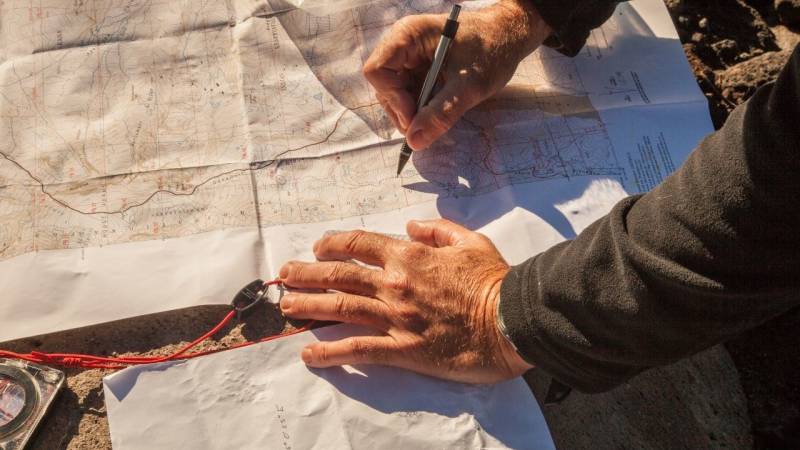
hiking map
Noun
Meaning
A hiking map is an essential tool for outdoor enthusiasts, providing detailed information about trails, landmarks, and topography. It helps hikers navigate through unfamiliar terrain, ensuring a safe and enjoyable hiking experience. With a hiking map, you can plan your route, estimate distances, and identify potential hazards or points of interest along the way. Whether you're exploring a national park, embarking on a multi-day trek, or simply going for a day hike, a reliable hiking map is a must-have item. It allows you to immerse yourself in nature, discover new trails, and confidently explore the great outdoors.

Examples
„I love exploring the wilderness, and a hiking map is an essential tool for me. It helps me navigate through unfamiliar trails and find my way back to civilization.“
„When I go hiking with my friends, we always make sure to bring a hiking map with us. It allows us to plan our route and discover new trails together.“
„During my last hiking trip, I met a fellow hiker who was lost in the woods. Luckily, I had a hiking map with me and was able to guide him back to the main trail.“
„As an experienced hiker, I always recommend beginners to carry a hiking map. It not only helps them stay on track but also enhances their overall hiking experience.“
„Exploring new hiking trails is one of my favorite activities, and a hiking map is like a treasure map for me. It leads me to hidden gems and allows me to immerse myself in nature's beauty.“
Origin
The word "hiking map" originates from the combination of the terms "hiking" and "map". The word "hiking" refers to the activity of walking or trekking in natural environments, typically on trails or footpaths. It is derived from the Middle Low German word "hiken", meaning "to limp" or "to walk with difficulty". The term "map" refers to a visual representation of an area, typically showing geographical features, roads, and landmarks.
The concept of using maps for hiking dates back centuries, with early explorers and adventurers relying on hand-drawn maps to navigate through unfamiliar territories. As technology advanced, printed maps became more widely available, providing hikers with detailed information about trails, elevation, and points of interest.
In recent years, the advent of digital mapping technologies and GPS devices has revolutionized the way hikers navigate and plan their routes. Hiking maps are now available in various formats, including paper maps, online maps, and mobile applications. These maps often include real-time information, such as weather conditions and trail updates, making them an essential tool for modern-day hikers.
Synonyms
Trail map, Trekking map, Walking map, Backpacking map, Outdoor map, Wilderness map, Navigation map, Adventure map
Antonyms
City map, Road map, Subway map, World map, Treasure map, Trail map, Topographic map, Nautical chart
Relatives
Hiking trail, Topographic map, Navigation, Compass, GPS, Orienteering, Backpacking, Outdoor exploration
Historical and cultural importance
A hiking map is an essential tool for outdoor enthusiasts, providing valuable information about trails, landmarks, and points of interest in a specific area. While the concept of mapping dates back thousands of years, the use of hiking maps as we know them today has evolved over time.
In ancient civilizations, maps were primarily used for navigation and exploration purposes. They were often hand-drawn and depicted geographical features, trade routes, and important landmarks. These early maps laid the foundation for the development of more detailed and accurate maps in later centuries.
During the Age of Exploration in the 15th and 16th centuries, maps became crucial for sailors and explorers venturing into unknown territories. Cartographers began to incorporate more precise measurements and geographical coordinates, enabling more accurate navigation.
As hiking and outdoor activities gained popularity in the 19th and 20th centuries, specialized hiking maps were created to cater to the needs of adventurers. These maps provided detailed information about trails, elevation changes, water sources, and other essential features for hikers.
Today, hiking maps have evolved further with the advent of technology. Digital maps and GPS devices have made navigation easier and more accessible. However, traditional paper maps still hold their charm and are preferred by many outdoor enthusiasts for their reliability and ease of use.
Whether you're planning a day hike or a multi-day trek, a hiking map is an invaluable resource that allows you to explore the wilderness with confidence and discover the hidden wonders of nature.
More information about the term hiking map
Exploring the Wilderness with a Hiking Map
When it comes to venturing into the great outdoors, a hiking map is an essential tool that no adventurer should be without. Whether you're a seasoned hiker or just starting out, a good hiking map can be your best friend, guiding you through unfamiliar terrain and ensuring you stay on track. In this article, we'll explore the importance of a hiking map and how it can enhance your wilderness experience.
Navigation Made Easy
One of the primary purposes of a hiking map is to help you navigate your way through the wilderness. With detailed topographic information, a hiking map provides a visual representation of the landscape, including trails, landmarks, and elevation changes. Armed with this knowledge, you can plan your route, estimate distances, and make informed decisions about your journey.
By following the trails marked on the map, you can avoid getting lost and stay on the right path. This is especially crucial when exploring unfamiliar areas or embarking on multi-day hikes. A hiking map gives you the confidence to explore new territories, knowing that you have a reliable guide to lead the way.
Discover Hidden Gems
Another advantage of using a hiking map is the ability to discover hidden gems along your route. While popular trails are often well-marked and frequented by other hikers, there are countless lesser-known paths and points of interest waiting to be explored. With a hiking map in hand, you can easily identify alternative routes, scenic viewpoints, and hidden waterfalls that may not be mentioned in guidebooks or online resources.
By venturing off the beaten path, you can experience the true beauty of nature and find solitude away from the crowds. A hiking map allows you to customize your adventure and create a unique experience that aligns with your interests and preferences.
Emergency Preparedness
One aspect of hiking that should never be overlooked is emergency preparedness. While we always hope for the best, it's important to be prepared for the unexpected. A hiking map can play a crucial role in emergency situations, helping you communicate your location to rescue teams or fellow hikers.
In the event of an injury or getting lost, a hiking map can provide vital information to guide search and rescue efforts. By marking your intended route and highlighting nearby landmarks, you can increase your chances of being found quickly and safely.
Conclusion
A hiking map is an indispensable tool for any outdoor enthusiast. It not only helps you navigate through the wilderness but also allows you to discover hidden gems and enhances your overall safety. So, before you embark on your next adventure, make sure to grab a hiking map and let it be your trusted companion on the trail.
Back to overview

